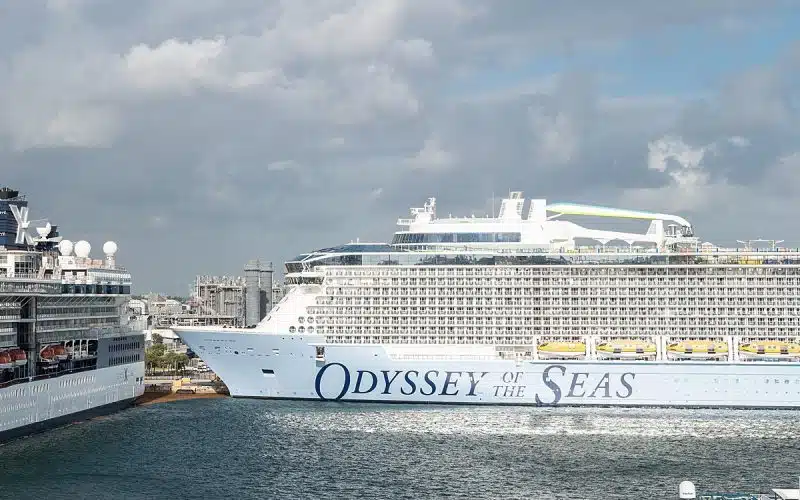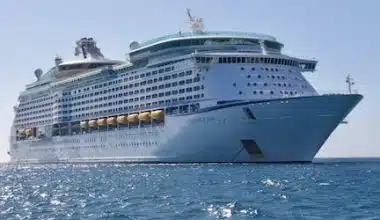Embark on a journey to understand the concept of closed-loop cruises. From the intricacies of their routes to the perks they offer, discover all you need to know about this maritime adventure. A closed-loop cruise departs and returns from the same U.S. port, visiting contiguous territories of the United States. U.S. citizens can take advantage of this convenient option, as they don’t need a passport to travel. The cruise offers a wide range of destinations that you wouldn’t want to miss. So this is an opportunity to find out what you can achieve, as we have provided you with all you need to know about a closed-loop cruise.
What Is A Closed Loop Cruise?
A closed-loop cruise is a type of cruise that departs from and returns to the same U.S. port. It is called closed-loop because the cruise itinerary does not involve traveling to any foreign countries that require a passport. Instead, the cruise may visit contiguous territories of the United States, such as Alaska, the Caribbean, Mexico, Canada, Bermuda, and Hawaii. U.S. citizens can take advantage of closed-loop cruises without needing a passport.
Features of a Closed-Loop Cruise
#1. Departure and Return from the Same U.S. Port
A closed-loop cruise is an itinerary that begins and ends at the same U.S. port. Passengers embark on the cruise from a U.S. port and return to the same port at the end of the trip.
#2. Contiguous Territories of the United States
To qualify as a closed-loop cruise, the itinerary must include places that are contiguous territories of the United States. This can include destinations such as Mexico, Canada, the Caribbean islands, Bermuda, Alaska, and Hawaii.
#3. No Passport Required for U.S. Citizens
One of the key features of a closed-loop cruise is that U.S. citizens do not need a passport to travel. Instead, they can enter or depart the country with proof of citizenship, such as a certified birth certificate or certificate of U.S. naturalization, along with a government-issued photo ID (if 16 years of age or older).
#4. Convenient Option for Travelers
Closed-loop cruises offer a convenient option for U.S. travelers who want to enjoy a cruise vacation without the need for a passport. This is particularly beneficial for those who may not have a valid passport or have an expired one.
#5. Wide Range of Destinations
Closed-loop cruises provide access to a variety of destinations. Depending on the specific cruise itinerary, passengers can visit places like Alaska, the Caribbean Islands, Mexico, Canada, Bermuda, and Hawaii.
#6. Simplified Entry and Exit Procedures
Since closed-loop cruises involve traveling within U.S. territories, the entry and exit procedures are generally simplified compared to international travel. Passengers can enjoy a smoother process when boarding and disembarking the cruise ship.
#7. No Visa Requirements
Since closed-loop cruises visit only U.S. territories or contiguous countries, there is generally no need for passengers to obtain visas. This simplifies the travel process, as passengers can avoid the paperwork and fees associated with visa applications.
#8. Familiar Currency
During a closed-loop cruise, passengers will typically use the U.S. dollar as the primary currency. This eliminates the need to exchange currency or deal with unfamiliar currencies, making transactions and budgeting easier for passengers.
#9. Access to U.S. Healthcare
In the event of a medical emergency, closed-loop cruises offer the advantage of being in closer proximity to U.S. healthcare facilities and services. This can provide passengers with a greater sense of security and access to medical care that aligns with their preferences.
#10. Simplified Itineraries
Closed-loop cruises tend to have simplified itineraries compared to international cruises. Since they do not involve multiple foreign ports, passengers can enjoy a more straightforward travel experience with fewer logistics to manage.
Closed-Loop Cruise, No Passport
A closed-loop cruise is a kind of cruise itinerary that doesn’t stop at any foreign ports that demand a passport; instead, it starts and finishes at the same U.S. port.
Documents Needed For A Closed-Loop Cruise Without A Passport
To go on a closed-loop cruise without a passport, U.S. citizens will need to provide the following documents:
#1. Proof of Citizenship
U.S. citizens must provide a certified birth certificate or a certificate of U.S. naturalization as proof of citizenship. This document verifies their U.S. citizenship and is required for entry and departure.
#2. Government-Issued Photo ID
Passengers who are 16 years of age or older will need to present a government-issued photo ID, such as a driver’s license or state ID card. This ID is used to verify the passenger’s identity.
#3. Boarding Pass
Passengers will need to present their boarding pass, which is typically provided by the cruise line upon check-in. The boarding pass serves as proof of reservation and allows passengers to board the cruise ship.
To Book A Closed-Loop Cruise Without A Passport
#1. Choose a Cruise Line
Research cruise lines that offer closed-loop cruises without passport requirements. Many major cruise lines, such as Carnival, Royal Caribbean, and Norwegian Cruise Line, offer these types of itineraries.
#2. Select an Itinerary
Look for cruise itineraries that are labeled as closed-loop or round-trip cruises. These itineraries depart and return to the same U.S. port, visiting contiguous territories of the United States.
#3. Check Required Documents
Review the cruise line’s website or contact their customer service to confirm the specific documentation required for a closed-loop cruise. Typically, you will need a certified birth certificate or a certificate of U.S. naturalization as proof of citizenship, along with a government-issued photo ID.
#4. Make a Reservation
Once you have chosen your preferred cruise line and itinerary, make a reservation either through the cruise line’s website or by contacting their customer service. Provide the necessary information, such as the number of passengers, desired cabin type, and preferred travel dates.
#5. Complete the Booking Process
Follow the instructions provided by the cruise line to complete the booking process. This may involve providing passenger information, making a deposit or full payment, and selecting any additional services or amenities.
#6. Prepare Required Documents
Gather the required documents for the closed-loop cruise, including your certified birth certificate or certificate of U.S. naturalization and a government-issued photo ID. Ensure that these documents are valid and meet the cruise line’s requirements.
#7. Arrive at the Port
On the day of departure, arrive at the designated port with your required documents, boarding pass, and any other necessary travel documents. Follow the instructions provided by the cruise line for check-in and boarding procedures.
Royal Caribbean Closed Loop Cruise
An itinerary that starts and ends at the same U.S. port is known as a closed-loop cruise by Royal Caribbean. This type of cruise allows U.S. citizens to travel without a passport, although it is always recommended to have a valid passport when traveling outside of the U.S.
Benefits of Royal Caribbean Closed Loop Cruise
Royal Caribbean offers several benefits for travelers who choose to embark on a closed-loop cruise. Including
#1. Convenience
Closed-loop cruises allow travelers to start and end their journey at the same U.S. port. This eliminates the need for additional travel arrangements to return to the original departure point.
#2. Wide Range of Destinations
Royal Caribbean offers a diverse selection of destinations for closed-loop cruises. Whether you prefer tropical Caribbean islands, Alaskan glaciers, Mediterranean cities, or exotic Asian ports, Royal Caribbean’s itineraries provide a variety of options to suit different travel preferences.
#3. Onboard Entertainment and Activities
Royal Caribbean is known for its exceptional onboard entertainment and activities. From Broadway-style shows and live music performances to water parks, rock climbing walls, and zip lines, there is something for everyone to enjoy. The cruise ship becomes a destination itself, offering a wide range of entertainment options throughout the journey.
#4. Dining Options
Royal Caribbean boasts a variety of dining options, including main dining rooms, specialty restaurants, casual eateries, and room service. From fine dining experiences to casual buffets, guests can indulge in a wide array of culinary delights, catering to different tastes and dietary preferences.
#5. Family-Friendly Amenities
To keep kids and adults occupied, Royal Caribbean provides a wide range of family-friendly facilities and entertainment options. Families may spend valuable time together while simultaneously providing their children with a room to play and make new friends.
#6. Relaxation and Wellness
Royal Caribbean provides opportunities for relaxation and wellness onboard. Guests can indulge in spa treatments, fitness classes, and yoga sessions, and even enjoy adults-only retreats, such as solariums and private lounges, for a peaceful and rejuvenating experience.
#7. Excursion Opportunities
A variety of shore excursions are available at different ports of call by Royal Caribbean. There are excursion alternatives to fit a variety of interests and tastes, whether you’re interested in seeing historical sites, trying out daring sports like zip-lining or snorkeling, or just lounging on a gorgeous beach.
#8. Crown and Anchor Society
Royal Caribbean has a loyalty program called the Crown and Anchor Society. As you accumulate points based on the number of nights you cruise and your cabin type, you can progress through different tiers, such as Gold, Platinum, Emerald, Diamond, Diamond Plus, and Pinnacle Club. Each tier offers various rewards and benefits, including discounts on the Internet, onboard merchandise, beverage packages, and certain fares.
#9. Casino Comps
Royal Caribbean’s Club Royale offers benefits to casino players, even on comped cruises. Members report receiving perks such as free play, specialty dinners, and onboard credit posted to their accounts by the hosts.
#10. Ground Transfers
Royal Caribbean offers easy-to-purchase ground transfers to and from the cruise ship. This service allows travelers to relax and let Royal Caribbean handle the transportation details, ensuring a smooth transition to and from the ship.
Carnival Closed-Loop Cruise
Carnival offers closed-loop cruises that begin and end at the same U.S. port. U.S. citizens can travel to various destinations without a passport, including Alaska, the Bahamas, Bermuda, and more. To prove citizenship, a certified birth certificate or certificate of U.S. naturalization is required, along with a government-issued photo ID for those aged 16 and above. Closed-loop cruises with Carnival provide convenience and eliminate the need for additional travel arrangements.
Downsides of a Carnival Closed-Loop Cruise
#1. Limited Destinations
While Carnival offers closed-loop cruises to various destinations, the options may be limited compared to open-loop cruises that allow for international travel. Closed-loop cruises typically focus on specific regions, such as the Caribbean, Alaska, or Bermuda.
#2. Limited Immigration and Customs Process
Closed-loop cruises involve a simplified immigration and customs process compared to international travel. While this can be convenient, it may also mean missing out on the experience of going through customs and exploring different countries.
#3. Itinerary Options
Closed-loop cruises may have limited itinerary options compared to open-loop cruises. If you’re looking for a more diverse and extensive itinerary that includes multiple countries and ports of call, an open-loop cruise may be a better choice.
#4. Limited Time in Ports
Closed-loop cruises often have limited time in each port of call. This means that you may have less time to explore and experience the destinations compared to longer open-loop cruises. If you prefer a more in-depth exploration of each port, a closed-loop cruise may not provide as much time for sightseeing and activities.
#5. Crowded Ports and Attractions
Popular closed-loop cruise itineraries can attract a large number of cruise ships, resulting in crowded ports and attractions. This can lead to longer wait times, crowded tourist sites, and a less intimate experience at each destination. If you prefer a quieter and less crowded travel experience, a closed-loop cruise may not be ideal during peak travel seasons.
#6. Limited Cultural Immersion
Closed-loop cruises often focus on tourist-friendly destinations and attractions, which may offer a more commercialized and less authentic cultural experience. A closed-loop cruise may not offer as many opportunities for cultural immersion and interaction with local communities for those seeking a deeper experience.
#7. Higher Costs for Onboard Services
While the base fare for closed-loop cruises may be attractive, it’s important to consider that additional onboard services and amenities may come at an extra cost. This can include specialty dining, beverage packages, spa treatments, and certain activities.
#8. Limited Flexibility
Closed-loop cruises operate on a fixed schedule with specific departure and arrival dates. This can limit your flexibility in terms of travel dates and duration. A closed-loop cruise may not provide the desired level of flexibility for those who prefer a more flexible travel experience.
Do I Need A Passport To Go On A Closed-Loop Cruise?
For a closed-loop cruise, U.S. citizens do not need a passport. Instead, they can use proof of citizenship, such as a certified birth certificate or a certificate of U.S. naturalization, along with a government-issued photo ID. Closed-loop cruises are those that start and end at the same U.S. port, visiting contiguous territories of the United States.
Does Disney Do Closed-Loop Cruises?
Yes, Disney Cruise Line offers closed-loop cruises. Many Disney Cruise Line itineraries are closed-loop cruises that sail in and out of the same port, allowing passengers to use proof of citizenship and a government-issued photo ID for entry and departure. Disney Cruise Line does not require a passport for closed-loop cruises.
What Are The Three Types Of Cruise Itineraries?
The three main types of cruise itineraries are perennial itineraries (year-round servicing), seasonal itineraries (based on demand during specific times of the year), and repositioning itineraries (longer journeys moving ships between regions). Perennial itineraries cater to stable demand, seasonal itineraries align with peak times, and repositioning itineraries allow for longer voyages and visiting multiple destinations. Cruise lines may offer variations or additional types of itineraries based on their specific offerings and destinations.
Do Cruise Ship Passengers Need Visas?
Visa requirements for cruise ship passengers can vary depending on factors such as the countries visited and the passenger’s nationality. U.S. citizens may not need visas for many popular cruise destinations, while non-U.S. citizens generally need a valid passport and may require a multiple-entry visa. Specific countries may handle visas for cruise passengers differently, and some cruises starting or ending in Turkey may require an e-visa or a visa obtained from an embassy or consulate.
Can Non-US Citizens Go On A Cruise?
Yes, non-U.S. citizens can go on a cruise. However, the specific travel documentation required may vary depending on factors such as the countries visited and the passenger’s nationality. Generally, non-U.S. citizens are required to carry a valid, unexpired passport and may also need a multiple-entry visa, if applicable. It’s important to note that cruise lines may have specific requirements and may not allow passengers to board without the necessary paperwork, even if they do not plan to disembark at any ports.
Conclusion
A closed-loop cruise requires U.S. citizens to provide proof of citizenship, a government-issued photo ID, and a boarding pass for entry and departure, ensuring they are 16 years of age or older. Royal Caribbean offers a closed-loop cruise, allowing U.S. citizens to travel without a passport. However, a valid passport is recommended for international travel. The cruise ship becomes a destination itself. Carnival offers closed-loop cruises, allowing U.S. citizens to travel to destinations without a passport. However, these cruises have limited destinations, simplified immigration and customs processes, and limited itinerary options.
- DO YOU NEED A PASSPORT TO GO TO BAHAMAS CRUISE?
- HOLIDAY CRUISES: Best Thrilling Destinations
- BEST CARIBBEAN CRUISE DEALS IN 2023-2024
- PLACES YOU CAN GO WITHOUT A PASSPORT IN 2023
- BEST TIME TO CRUISE THE CARIBBEAN






